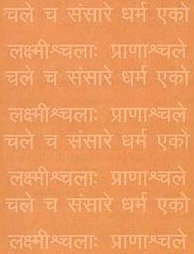Dvadashaditya, Dvādaśāditya, Dvadasha-aditya: 4 definitions
Introduction:
Dvadashaditya means something in Hinduism, Sanskrit. If you want to know the exact meaning, history, etymology or English translation of this term then check out the descriptions on this page. Add your comment or reference to a book if you want to contribute to this summary article.
The Sanskrit term Dvādaśāditya can be transliterated into English as Dvadasaditya or Dvadashaditya, using the IAST transliteration scheme (?).
In Hinduism
Purana and Itihasa (epic history)
Source: archive.org: Puranic EncyclopediaDvādaśāditya (द्वादशादित्य).—The twelve sons born to Kaśyapa by his wife Aditi are called Dvādaśādityas (Twelve Ādityas) The word Āditya means 'born of Aditi'. As it occurs in Agni Purāṇa (Ch. 51) a table, showing the names of the twelve Ādityas and the sign of the Zodiac over which each Āditya predominates and the colour of it, is given below. Dvādaśādityas. Sign of the Zodiac. Colour
1 Varuṇa. Meṣa (Aries) Black.
2 Sūrya (Sun) Rṣabha (Taurus) Blood-colour.
3 Sahasrāṃśu Mithuna (Gemini) Slightly redcolour.
4 Dhātā Karkaṭaka (Cancer) Yellow.
5 Tapana Siṃha (Leo) White.
6 Savitā Kanyā (Virgo) Pure white.
7 Gabhasti Tulā (Libra) tawny colour.
8 Ravi Vṛścika (Scorpio) Yellow.
9 Parjanya Dhanu (Sagittarius) Parrot-colour.
10 Tvaṣṭā Makara (Capricorn) Snow-white.
11 Mitra Kumbha (Aquarius) Smoky hue.
12 Viṣṇu* Mīna (Pisces) Blue.
*) This version of the episode is found in Mahābhārata. The poet Kālidāsa has made variations, suitable to his work, the Abhijñāna-Śākuntala. Some deviations from the Mahābhārata story may be noticed in the works of some other poets also. 2. Different names of Ādityas occur in different Purāṇas. The names given here are based on the Agni Purāṇa. (See full article at Story of Dvādaśāditya from the Puranic encyclopaedia by Vettam Mani)
Source: Shodhganga: The saurapurana - a critical studyDvādaśāditya (द्वादशादित्य) refers to the “land of the Sun”, according to the 10th century Saurapurāṇa: one of the various Upapurāṇas depicting Śaivism.—Accordingly, Sūta said that once Manu, the son of Sūrya went to a forest named Kāmika, where the sages Bhṛgu and others were trying to determine the highest truth on the occasion of a great sacrifice instituted by king Pratardana. Being unable to come to a conclusion the sages went with Manu to Dvādaśāditya, the land of the Sun and practiced penance there for thousand years. The Sun was pleased and appeared before Manu, who then eulogised him...

The Purana (पुराण, purāṇas) refers to Sanskrit literature preserving ancient India’s vast cultural history, including historical legends, religious ceremonies, various arts and sciences. The eighteen mahapuranas total over 400,000 shlokas (metrical couplets) and date to at least several centuries BCE.
Vedanta (school of philosophy)
Source: Shodhganga: Siva Gita A Critical StudyDvādaśāditya (द्वादशादित्य) refers to.—
- Mitra,
- Ravi,
- Sūrya,
- Bhānu,
- Gaga,
- Pūṣa,
- Hiraṇyagarbha,
- Marīci,
- Āditya,
- Savitā,
- Arka,
- Bhāskara.

Vedanta (वेदान्त, vedānta) refers to a school of orthodox Hindu philosophy (astika), drawing its subject-matter from the Upanishads. There are a number of sub-schools of Vedanta, however all of them expound on the basic teaching of the ultimate reality (brahman) and liberation (moksha) of the individual soul (atman).
Languages of India and abroad
Sanskrit dictionary
Source: Cologne Digital Sanskrit Dictionaries: Monier-Williams Sanskrit-English DictionaryDvādaśāditya (द्वादशादित्य):—[from dvā-daśa > dvā] (in [compound]) the 12 Ādityas
Sanskrit, also spelled संस्कृतम् (saṃskṛtam), is an ancient language of India commonly seen as the grandmother of the Indo-European language family (even English!). Closely allied with Prakrit and Pali, Sanskrit is more exhaustive in both grammar and terms and has the most extensive collection of literature in the world, greatly surpassing its sister-languages Greek and Latin.
See also (Relevant definitions)
Partial matches: Aditya, Dvadasha.
Starts with: Dvadashadityamantra, Dvadashadityashrama, Dvadashadityastava, Dvadashadityatirtha.
Full-text: Dvadashadityastava, Dvadashadityatirtha, Dvadashadityashrama, Bhaskara, Tushita, Savita, Mitravaruna, Kamika, Vivasvan, Tuvatacatittar, Dhata, Aditi, Pratardana, Surya, Bhaga, Divine chariot.
Relevant text
Search found 7 books and stories containing Dvadashaditya, Dvādaśāditya, Dvadasha-aditya, Dvadasaditya, Dvādaśa-āditya, Dvadasa-aditya; (plurals include: Dvadashadityas, Dvādaśādityas, adityas, Dvadasadityas, ādityas). You can also click to the full overview containing English textual excerpts. Below are direct links for the most relevant articles:
Puranic encyclopaedia (by Vettam Mani)
Early Chola Temples (by S. R. Balasubrahmanyam)
Kailasanathar Temple < [Chapter XIV - Conclusion]
The Skanda Purana (by G. V. Tagare)
Chapter 191 - The Greatness of Dvādaśāditya Tīrtha < [Section 3 - Revā-khaṇḍa]
Chapter 139 - Greatness of Citrāditya (Citra-āditya) < [Section 1 - Prabhāsa-kṣetra-māhātmya]
Chapter 230 - The Series of Tīrthas Enumerated < [Section 3 - Revā-khaṇḍa]
Vedic influence on the Sun-worship in the Puranas (by Goswami Mitali)
Sun-worship Vratas (21) Dvādaśāditya-vrata < [Chapter 5 - Rituals Related to the Sun-Worship in the Purāṇas]
Part 10 - Temples and Pilgrimages for Worshipping the Sun-god in the Purāṇas < [Chapter 4 - Vedic Influence on the Sun-Worship in the Purāṇas]
Shat-cakra-nirupana (the six bodily centres) (by Arthur Avalon)
Verse 47 < [Section 7]